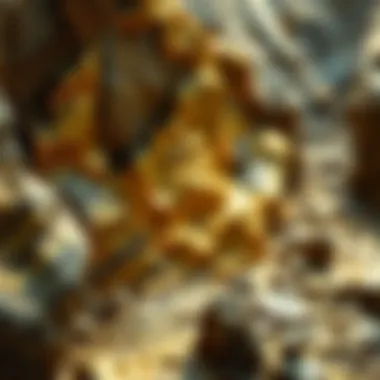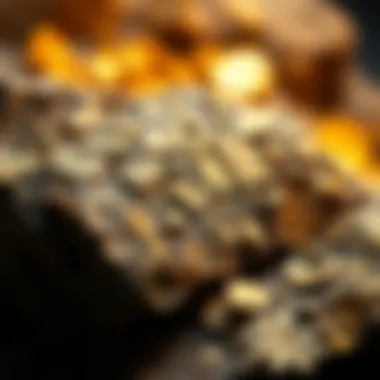Exploring the Connection Between Rock and Gold


Intro
Gold and rocks have coexisted throughout history, creating a bond that goes far beyond mere aesthetics. For collectors and enthusiasts, understanding this relation can unveil a realm of geological wonders, rich narratives, and economic implications. Whether it’s a glimmering nugget or an ordinary stone, there’s a story behind each captivating piece that deserves attention. In this exploration, we will journey through antiquity into modern collections, searching for the interconnections between geology, culture, and the allure of gold.
History and Origins
Overview of Collectibles, Rocks, and Fossils
The fascination with rocks and minerals is nothing new; collectors have been at it for centuries. Since ancient civilizations, people have marveled at the beauty and rarity of rocks, particularly those containing precious metals like gold. Understanding the genesis of these materials provides insight into their value and significance.
When considering collectibles, rocks often fall into categories like minerals, fossils, and gemstones. Gold itself is usually found within quartz veins or sedimentary rock, often shaped by millennia of geological processes.
- Minerals: Naturally occurring compounds, like quartz and calcite
- Fossils: Remnants of ancient life embedded in rocks, giving us a glimpse into Earth’s past
- Gemstones: Rare and beautiful stones that are often cut and polished for jewelry
These classifications help collectors not only store their treasures but also appreciate their uniqueness. Understanding geological formations and local rock types can also immensely enhance the collection experience.
Historical Significance and Cultural Impact
Gold has been a pivotal element in many cultures - serving as a symbol of wealth, power, and divine favor. The ancient Egyptians, for example, regarded gold as the flesh of the gods, and it was often found in burial sites alongside precious artifacts.
"Gold is a treasure that knows no time. It carries the weight of history, culture, and earth's artistry."
In the Americas, indigenous peoples extracted gold and shaped it into stunning ornamental items long before European colonization. The Incas viewed gold as the ‘sweat of the sun.’ Even in modern times, gold still holds a significant role in various belief systems and economic frameworks. From ancient rings to contemporary jewelry, gold remains a coveted material across the globe.
Let's delve deeper into the implications of these relationships, exploring how the ongoing extraction processes and collector practices are affected by these historical perspectives.
Identification and Classification
Guide to Identifying Rocks and Fossils
Recognizing a piece of rock can be as simple as observing its color or texture, but knowing how to classify it properly opens new doors to understanding. The field of geology provides tools and methods for amateur and professional collectors alike.
Key Identification Criteria:
- Color: While not definitive, color can offer initial clues.
- Luster: Is it metallic, glassy, or dull?
- Streak: Rubbing the mineral on a streak plate reveals its true color.
- Hardness: The Mohs scale helps in categorizing mineral strength.
It’s common for collectors to gather various specimens, but distinguishing between them enhances both value and appreciation. Fossils, on the other hand, require an added layer of scrutiny, often hinging on the structure and the surrounding sedimentary matrix in which they are found.
Common Types and Variations
Within the realm of gold-bearing rocks, several types stand out:
- Quartz Veins: Commonly associated with gold deposits, quartz veins exhibit clear crystal patterns.
- Conglomerate: Rocks that cement finer particles together; they may contain gold nuggets.
- Alluvial Deposits: Gold particles worn down from their source and transported by water.
For rock collectors, recognizing the distinctive features of these variations not only enlightens their collection but also enriches their understanding of geological history. Collecting is more than just obtaining items—it's about cultivating knowledge and passion for the Earth's intricate tapestry.
Foreword
The relationship between rocks and gold is a captivating one, filled with historical significance and geological intrigue. This article seeks to shine a light on how these two elements intersect, revealing the deeper connections that enrich our understanding of both geology and the allure of gold.
From the very beginnings of human civilization, gold has been a symbol of power and wealth. Yet, its origins lie buried within the rocks of the Earth. In exploring this intersection, we uncover not only the processes that form gold deposits but also the historical contexts that have shaped our perceptions of this precious metal. It transforms a simple material into a storied artifact steeped in lore, economy, and scientific inquiry.
In essence, this topic serves as a bridge to a broader understanding of not just gold itself, but the geological landscapes it inhabits. Collectors and hobbyists alike can learn how to identify, value, and appreciate gold-containing rocks while recognizing their environmental and cultural impacts. By grasping the foundational elements of rocks and minerals, as well as the historical contexts surrounding gold, enthusiasts can refine their expertise in any related ventures.
Advanced knowledge of how these mineralogical formations occur and the techniques used in their extraction opens the door for better appreciation and responsible collection practices. As we delve into this narrative, we will explore the individual facets including the geological significance of gold deposits, methods of extraction, and the values these materials hold in market and culture, thus making this exploration an essential guide for all who dwell in the realm of rock and fossil collecting.
Through this journey, readers will deepen their appreciation for the intricacies of the Earth, standing on the solid ground of science while gazing at the shimmering potential of gold.
Understanding Rocks and Minerals
To fully grasp the significance of gold, one must first understand the foundational elements of rocks and minerals. Rocks, composed of one or more minerals, form the crust of our planet and contain stories etched in their layers. These materials tell of volcanic eruptions, shifts in tectonic plates, and epochs of time that have molded them into what they are today.
Minerals themselves are defined by their specific chemical compositions and crystalline structures. Gold, for instance, is classified as a native element, meaning it occurs in its pure form within geological environments. This quality lends itself to recognition amongst fellow minerals. Other minerals, like quartz or pyrite, can serve as indicators of gold's presence. Recognizing these associations can be key for prospectors and collectors seeking to unearth nature's treasure.
- Types of Rocks:
- Igneous Rocks: Formed from cooled magma, these rocks can host valuable minerals.
- Sedimentary Rocks: Created by compacted sediments and can include materials that have eroded from other rock types.
- Metamorphic Rocks: Altered under heat and pressure, these formations can also lead to gold deposits through processes like hydrothermal activity.
Furthermore, understanding the mineral composition provides insights into the extraction processes that follow. The characteristics of a rock can determine the methods used in mining it for valuable materials. Knowing the difference between these rocks helps aspiring collectors and researchers consider the nuances of their targets. Henceforth, rocks are not merely a subject of aesthetics; they are canvases of Earth’s history and harbingers of potential wealth.
Historical Context of Gold


Gold has entranced humanity for millennia. Since the dawn of recorded history, it has been prized not just for its beauty but for the cultural and economic systems that revolve around it. In ancient civilizations, such as the Egyptians and the Incas, gold was not just a currency; it was intertwined with religious beliefs and practices.
The allure of gold has compelled humankind to undertake unbelievable challenges to extract it from the earth. Countries have risen and fallen based on their gold reserves, and the search for this precious metal has often driven exploration and colonization.
Looking back, events like the California Gold Rush in the mid-1800s showcase how gold has spurred mass migrations and shaped societies. Towns sprang up overnight, teeming with prospectors fueled by dreams of fortune. This frenetic energy around gold mining has had lasting impacts on economies and cultures, both local and global.
- Influence of Gold in Trade and Economy:
- Gold-based currencies
- Bartering systems rooted in gold's value
The history of gold reflects the evolving relationship between humans and their environment. It poses questions about scarcity, value, and ethical considerations, especially in modern context where sustainable practices are imperative.
As we dissect these elements throughout the article, readers can gain insights not just into the allure of gold but also into the geological realities that bring this metal to our world. Understanding the legacy that gold carries enables collectors and both enthusiasts and professionals to approach their pursuits with a sense of respect and awareness.
Geological Significance of Gold Deposits
The geological significance of gold deposits cannot be overstated. These formations provide not only an understanding of Earth's processes and history but also a critical economic resource. Gold deposits reveal valuable information about crustal evolution, tectonic activity, and even ancient environmental conditions. By studying these minerals, researchers gain insights into the geological forces that have shaped our planet over millions of years. Moreover, gold relevancy extends beyond geology; it plays a pivotal role in today’s economy, influencing markets and investments.
Types of Gold Ores
Vein Deposits
Vein deposits are characterized by their occurrence in quartz veins or fractures within rock, showcasing the sheer beauty of nature's designs. These deposits are formed when gold-bearing fluids circulate through cracks in the rock, depositing gold as they cool. This particular type of gold ore is valuable due to its relatively high grade; veins often have a greater concentration of gold compared to other deposit types.
One of the key characteristics of vein deposits is their spatial distribution. They tend to cluster in specific areas, often leading to profitable mining ventures. However, mining these veins can be quite labor-intensive, requiring considerable effort and resources. Despite this, the rewards often outweigh the challenges, making vein deposits a popular target for miners and collectors alike.
"The allure of finding a rich vein of gold has driven many dreams and ventures since the dawn of mining."
Alluvial Deposits
Alluvial deposits refer to gold that resides in riverbeds or floodplains. This type of gold is usually deposited by movement of water, leading to the gradual accumulation of gold particles. Alluvial deposits are often more accessible than vein deposits, making them the go-to choice for amateur prospectors and small-scale miners who favor simpler extraction methods.
What sets alluvial deposits apart is their ease of access and the relatively low cost of extraction. They allow for a more relaxed approach—rather than digging deep into rock, miners can simply sift through river sand. However, the downside is that alluvial deposits often yield gold of lower purity. While they may attract hobbyists, the economic viability can vary significantly depending on the location and volume of deposit.
Lode Deposits
Lode deposits are another major type of gold ore, typically found in hard rock formations. Unlike alluvial deposits, lode deposits are embedded within the matrix of rocks and require significant mining operations to extract. They are essential for commercial gold production, as they usually contain the highest concentrations of gold.
The defining characteristic of lode deposits is their size and consistency, which can lead to long-term mining operations. This can be highly profitable, but it often requires advanced technology and large investments to operate efficiently. The reliability of lode deposits can be their strongest suit, attracting corporations that seek sustainable and extensive operations. However, the environmental implications must also be considered, as lode mining can be destructive to ecosystems.
Formation Processes of Gold in Rocks
The formation of gold within rocks is a complex process that involves numerous geochemical and geological factors. Gold can form through several mechanisms, such as hydrothermal processes, magmatic processes, or even sedimentary deposition. Understanding these processes provides a clearer picture of gold’s origin and its eventual distribution on Earth.
These formation processes reflect the intricate interplay of heat, pressure, and chemical reactions that occur deep within the Earth’s crust. Factors like temperature and the presence of particular minerals heavily influence the formation and concentration of gold.
Gold Extraction Methods
The extraction of gold from rocks is a critical topic within the realm of geology and mining. Delving into gold extraction methods is paramount for understanding not only the practicality and mechanics of getting gold from its ore but also the broader implications it has on the environment and economics. In this section, we will cover both historical mining techniques and modern methods, focusing on their applicability, effectiveness, and challenges in today’s context.
Historical Mining Techniques
Historically, gold extraction has evolved significantly, but the old ways still carry weight. Simple tools like panning in rivers go back to ancient civilizations. Panning involves using a shallow pan to wash gravel, allowing the heavier gold particles to settle at the bottom. It’s an accessible method, requiring minimal equipment and effort.
Another traditional method was the use of fire to separate gold from ores. This technique, known as smelting, involves heating the ore with a flux, which helps to release the metal. Although effective, this method produces substantial emissions and can damage the environment.
In more advanced historical practices, mining operations utilized techniques such as hard rock mining, where miners would dig tunnels underground to extract ore from veins. This method is labor-intensive and poses risks due to potential cave-ins, yet it remains necessary for accessing deeper deposits. Historical mining, while primitive by today’s standards, forms the backbone of our current understanding of extraction methods.
Modern Extraction Methods
As technology progressed, newer methods that are more efficient and less damaging to the environment emerged. Each extraction method today serves its purpose based on the type of ore, location, and desired outcome.
Cyanide Leaching
Cyanide leaching has garnered much attention over the years as a primary method for extracting gold from low-grade ore. This technique involves dissolving gold in a cyanide solution, which allows it to be separated from unwanted materials.
One key characteristic of cyanide leaching is its effectiveness in processing large volumes of ore quickly. This method is considered beneficial because it maximizes extraction rates while reducing the overall cost of operation. The unique feature here lies in the selectivity; cyanide selectively binds with gold, making it easier to isolate from other minerals.
However, the use of cyanide raises significant environmental concerns. Cyanide is highly toxic, and improper handling can lead to catastrophic outcomes for local wildlife and ecosystems. As a result, responsible management practices and regulations have become paramount in ensuring that cyanide leaching is conducted safely and sustainably.
Gravity Concentration


Gravity concentration techniques rely on the physical differences in the density of gold compared to other minerals to facilitate extraction. This method utilizes the natural settling behavior of particles in water or during a shaking process to concentrate gold. One of the most celebrated forms of gravity concentration is the sluice box, where water flows over riffles to catch gold grains.
A key characteristic of gravity concentration is its simplicity and efficiency in separating gold from high-grade ores. It is particularly beneficial as it avoids the use of harmful chemicals, making it environmentally friendly compared to other methods. However, it requires a higher concentration of gold in the ore to be effective, limiting its use in lower-grade deposits.
Flotation
Flotation is another modern extraction method used to separate gold from other minerals based on their hydrophobic properties. This process involves adding chemicals to a slurry of crushed ore, creating bubbles that attach to gold particles and float them to the surface. The floated material can then be skimmed off for further processing.
The primary advantage of flotation lies in its ability to process complex ores, especially those containing other valuable minerals alongside gold. It’s a widely accepted choice due to its high recovery rates and versatility in handling various types of ores. Nevertheless, flotation can be resource-intensive and cater to a need for careful management of the chemicals used, which raises potential environmental concerns.
As mining continues to evolve, understanding both historical and modern extraction techniques is essential for improving practices and minimizing environmental impacts while maximizing gold recovery.
Overall, the progression from historical to modern extraction methods illustrates a fascinating evolution in technology and environmental awareness. Each method, with its unique advantages and shortcomings, contributes significantly to the ongoing dialogue about responsible and effective gold extraction.
The Value of Gold in Collectibles
The significance of gold in the realm of collectibles cannot be overstated. This precious metal has played a pivotal role not just in financial markets, but also in the cultural fabric across civilizations. For collectors, acquiring gold-infused rocks or collectibles bearing gold's hallmark is akin to holding a piece of history, art, and value in their hands. The importance of this topic lies in its intricate blend of geology, economics, and personal passion that drives the collectability of these items.
Market Demand and Trends
Understanding market demand is paramount for any collector keen on making informed decisions. Over the years, the allure of gold has consistently drawn in a crowd, influencing trends and shaping the agendas of rock and mineral collectors. The interest in gold collectibles often spikes during economic uncertainty as individuals flock to it as a safe investment. As a result, the volatility of other markets can actually boost the value of gold, making it a sustainable choice for collectors.
However, it's not just about economic factors. The narrative around gold has evolved; younger generations are increasingly appreciative of its aesthetic and intrinsic value. This demographic shift has facilitated new trends in gold collecting. For instance, the rise of online platforms means that collectors can easily find and acquire specimens that were previously hard to come by. This accessibility has ignited an enthusiasm that is palpable among hobbyists.
Valuation of Gold-Containing Rocks
Valuating gold-infused rocks is a nuanced task that involves several considerations. Factors like purity, weight, and the unique attributes of the rock play crucial roles in determining its market value. Understanding these factors not only helps collectors make wise purchases, but also enables sellers to price their goods appropriately.
Factors Affecting Value
When it comes to assessing the value of gold-containing rocks, several key aspects come into play. Purity of Gold is often regarded as the primary consideration. It refers to the quality or fineness of the gold within the rock, measured in karats. Generally, higher karats equate to greater value.
How abundant the gold is in relation to the rock also matters. If a specimen contains a significant amount of gold, it will command a higher price. Yet, the location where the rock was found can add to its allure as well. Specimens from renowned gold-producing regions can fetch higher bids simply due to their pedigree.
However, it’s essential to be cautious. Not every shiny rock is gold-laden, so a lack of proper understanding can lead to significant losses.
Appraisal Guidelines
Navigating the world of rock appraisal can be tricky but is essential for collectors wishing to understand the true value of their specimens. One fundamental guideline is to seek professional appraisal from qualified gemologists or mineralogists. They utilize advanced techniques and tools to identify the key characteristics of each rock, such as its mineral composition, size, and grade of the gold.
Another notable aspect is market trends. Supply and demand can fluctuate, so the value of gold-containing rocks can change over time. Keeping an eye on auction results and sales can offer insight into current market conditions. Engaging with dedicated collecting communities, perhaps on platforms like reddit.com or facebook.com, can also provide fresh perspectives on valuation.
“To collect gold-infused rocks is not just a hobby; it's a journey through time and value.”
Environmental Considerations
Environmental considerations play a pivotal role in understanding the balance between gold extraction and ecological health. The pursuit of gold, while economically significant, often poses serious challenges for the environment. Striking a balance that both preserves natural habitats and meets human demands for gold is crucial for collectors and the broader community.
Impact of Gold Mining on Ecosystems
Gold mining can leave a significant mark on ecosystems. Often, the process involves clearing vast areas of land, which not only disrupts existing habitats but also leads to soil erosion and the destruction of biodiversity. Heavy machinery and the use of chemicals can contaminate water sources, affecting both aquatic life and communities dependent on these resources.
Another concern is the impact on air quality. Dust from mining operations and the combustion of fossil fuels release particulate matter into the atmosphere, which may contribute to respiratory issues among local populations.
“While gold glimmers with promise, it often buries the cost of extraction deep within the soil it comes from.”
In regions where forests are rich in biodiversity, mining can lead to the extinction of species that could take decades to recover, if they can recover at all. Therefore, understanding the local ecosystems and employing proper precautions can help minimize the adverse effects of mining ventures.
Key Points on Ecosystem Impact:
- Habitat Destruction: The removal of vegetation and soil leads to habitat loss.
- Water Contamination: Chemicals used in extraction can seep into rivers and lakes, harming wildlife.
- Air Pollution: Mining activities can release dust and other pollutants that affect air quality.
Sustainable Mining Practices
As awareness about environmental impacts grows, so does the need for sustainable mining practices. These methods aim to limit environmental harm while still meeting economic demands.
One crucial practice is the implementation of responsible waste management. Rather than disposing of mining waste recklessly, companies are encouraged to develop recycling methods or safely manage tailings, reducing the hazards associated with potential spills.
Another important aspect is the rehabilitation of mined land. This involves restoring the environment to its original state or developing it in a way that enhances biodiversity post-mining. Organizations can plant native flora that not only reestablishes a natural ecosystem but also could potentially contribute to the local economy.
Additionally, utilizing innovative technologies in extraction can minimize land disruption. For instance, smaller-scale operations that leverage advanced tools may extract gold more efficiently with less environmental impact, preserving surrounding ecosystems.


Strategies for Sustainable Practices:
- Effective Waste Management: Recycling and safe disposal of mining waste.
- Land Rehabilitation: Restoring vegetation post-mining to promote biodiversity.
- Technological Innovation: Implementing advanced extraction methods that lessen land disturbance.
By adopting sustainable mining practices, the gold industry can contribute to environmental health rather than detrimentally affect it. Collectors, hobbyists, and enthusiasts alike benefit when these environmental considerations are prioritized. Understanding the implications of gold extraction helps us make informed decisions on the purchasing and collecting of gold-infused rocks.
For further reading on sustainable mining, check out resources from the Environmental Protection Agency and the United Nations Environment Programme.
Cultural Aspects of Gold
Gold has captivated human beings for millennia, transcending its mere status as a precious metal to embody profound cultural significance. Understanding these cultural layers is crucial in appreciating gold not just as an element found in the earth but as a symbol intricately woven into the tapestry of human history, aspirations, and social structures.
Gold in Ancient Civilizations
Gold has long been associated with power, wealth, and divine favor in many ancient civilizations. For instance, the Egyptians viewed gold as a divine material, linking it deeply with their gods and the afterlife. The famous burial mask of Tutankhamun, crafted from gold, exemplifies this belief as it was meant to aid the pharaoh’s journey into the afterlife. This highlights how gold was not merely decorative but served a sacred purpose.
The ancient Greeks, too, held gold in high regard. The Greeks believed that gold could confer a sense of immortality. Mythological stories, such as that of King Midas, who could turn everything he touched into gold, showcase the allure and power associated with this metal.
In Mesoamerica, civilizations such as the Aztecs and the Incas viewed gold as the “sweat of the sun.” They crafted intricate jewelry and ceremonial objects, using gold as an offering to their gods, thereby intertwining religious devotion with the physical beauty and wealth represented by the metal.
The importance of gold during these periods cannot understated, as it often dictated social hierarchies and marked status among classes. Gold items served as both wealth and currency, often used in trade or as gifts to cement political alliances. It’s fascinating to think about how, even then, the intertwining of gold, culture, and status created an enduring legacy, one that reverberates even in today's societies.
Modern Symbolism and Uses of Gold
In contemporary society, gold continues to symbolize wealth and status but also represents a more complex set of ideas and values. It appears in various forms�—ranging from jewelry and financial investments to its use in electronics. The allure of gold persists in popular culture, where it often epitomizes success and achievement. The phrase "worth its weight in gold" effectively underscores the idea that something valuable should be measured against the worthiness associated with gold itself.
Moreover, gold is a significant airline in finance and investment markets. It acts as a hedge against inflation and economic downturns. Investors flock to gold during economic uncertainties, reinforcing its role as a "safe haven" asset. This tendency reflects a modern cultural belief that clings to gold’s historical role as a symbol of reliability.
Gold is also used in cultural tokens, such as wedding rings, marking significant life events with a material that signifies commitment and fidelity. In many cultures, gifting gold is seen as an expression of love or appreciation, often imbuing personal relationships with the weight of this precious metal.
As a versatile element, gold occupies a unique place in science as well, appearing in dental fillings, electronics, and even space technology because of its resistance to corrosion and excellent conductivity. This modern twist furthers the narrative that gold isn't merely a relic of the past but continues to evolve while retaining its significance.
"Gold holds value not just for its beauty, but for its enduring legacy spanning across ages and cultures."
By integrating the historical and modern aspects, we gain a richer perspective on gold’s role in our lives. Recognizing gold as a cultural artifact, imbued with varied meanings and implications, enhances its appreciation—even among rock collectors and hobbyists exploring the geological connections of gold in rock formations. Thus, gold becomes a bridge linking our past to our present and perhaps, our future.
Collecting Gold-Infused Rocks
The act of collecting gold-infused rocks is not just a hobby; it’s an intricate dance between nature’s art and humanity’s thirst for precious resources. There’s something mesmerizing about holding a shard of stone in your hand, knowing it holds a trace of gold, a symbol of both wealth and natural history. This section scrutinizes the significance of collecting these unique specimens, exploring what makes them valuable, and why enthusiasts passionately pursue them.
Identifying Authentic Specimens
In a world where reproductions abound, one crucial skill for collectors is the ability to differentiate authentic specimens from mere imitations. The thrill lies in seeking out that genuine piece, rich with stories and geological integrity. To effectively spot authentic gold-infused rocks, collectors should look for several tell-tale signs:
- Visual Appearance: Genuine gold typically exhibits a distinctive yellow hue, often with a metallic sheen. Look for those specks glinting under light, as they can be a solid indicator of authenticity.
- Weight and Density: Gold is significantly denser than most common minerals. If the rock feels unusually heavy for its size, it might contain real gold.
- Scratch Test: Running a piece across an unglazed ceramic plate can reveal its secrets. Authentic gold will leave a golden streak, while fakes will leave a black mark.
- Professional Verification: When in doubt, it’s wise to get insights from professionals or reputable gemologists.
The excitement of finding an authentic specimen goes beyond its monetary value; it ties back into the geological history and the tales of ancient earth that shaped it.
Care and Preservation Techniques
Once you’ve secured your gold-infused treasures, the next step is to ensure they’re kept in pristine condition. Stone and metal need care, and collectors should adopt specific strategies to maintain their integrity:
- Clean Gently: Avoid harsh chemicals. Instead, use a soft brush and lukewarm water to remove dust or dirt. This method preserves the natural qualities of both rock and gold.
- Store Properly: Make sure to keep them in a cool, dry place. Using a felt-lined case not only protects them from scratches but also keeps their sheen intact.
- Temperature Control: Just as you wouldn’t expose fine wine to extreme temperatures, rocks shouldn’t be left in overly humid or hot places. Aim for a steady climate to prevent any potential degradation.
- Insurance and Documentation: If your collection has significant value, consider documenting each piece with detailed descriptions and photographs for insurance purposes. This practice not only safeguards your investment but also provides you with personal records of your passion.
Proper care extends the lifespan of your collection and ensures it remains a point of pride, rather than a source of regret.
Ultimately, collecting gold-infused rocks offers a deeper connection to geology and history. Each piece embodies a fusion of ancient processes and modern appreciation, highlighting the enduring allure of gold amidst the rugged beauty of stone.
Closure
The exploration of rock and gold is far more than just the interaction between two natural materials; it serves as a bridge linking geological phenomena with human history and culture. This article sheds light on the intertwined paths of these two subjects, revealing the complexities that lie within.
As we curtail the discussion, it becomes clear that gold's rarity and allure don't solely arise from its intrinsic properties but also from the cultural narratives and economic factors that have developed over centuries. The historical context discussed earlier provides a rich tapestry of stories that underscore the significance of gold throughout different civilizations. This connection allows collectors and enthusiasts to appreciate their specimens not only as items of value but also as pieces of history.
The Future of Gold and Rock Collecting
Looking ahead, the world of gold and rock collecting seems promising yet challenging. The days where you could simply find gleaming gold nuggets in riverbeds are well behind us. Today, collectors are part of a more nuanced environment that demands higher levels of knowledge and careful strategy.
- Technological Advances: Innovations in mining and extraction techniques are changing the face of gold availability. For enthusiasts, staying informed about these advancements can yield significant benefits in terms of sourcing and identifying valuable specimens.
- Environmental Concerns: Sustainability in mining practices will play an increasingly important role. Collectors should be aware of ethically sourced rocks and how their investments impact the environment.
- Cultural Significance: The value of gold is not just economic; it holds cultural and emotional significance for many. Factors such as ever-changing aesthetic trends in collections and shifts in global market demands will shape future collecting.
Gold-infused rocks will likely become a sought-after commodity, emphasizing the need for discerning collectors to stay informed and adaptive.
In summary, the intersection of rock and gold is a dynamic field that continues to evolve. By understanding the past, present, and future of this relationship, enthusiasts can navigate the landscape of collection with wisdom and foresight.
"In the grand scheme of things, every piece of gold in a rock tells a story, not just of the earth, but of the people who sought it out."
The future is filled with opportunities as well as responsibilities. Collecting can be a path to deeper appreciation of both geology and the significant roles these processes play in our lives.



